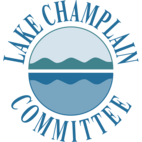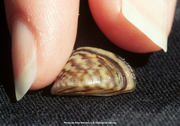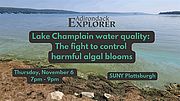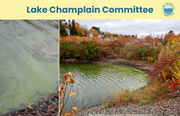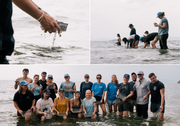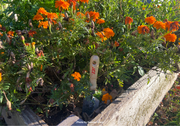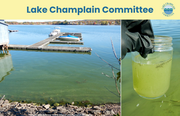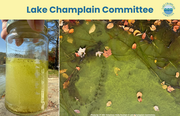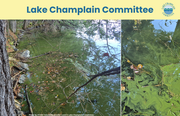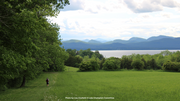Invasive zebra mussels are found throughout Lake Champlain, from the southern reaches of the lake to the northern bays in Quebec, growing in dense clusters and harming the lake's ecosystem, recreational access, and economic viability. And if zebra mussels are bad, Lake Champlain does not want to meet their cousin: the quagga mussel. Read...
LCC's Executive Director Jenny Patterson joined a panel of experts hosted by Adirondack Explorer in early November 2025 about Lake Champlain's water quality and the high cost of inaction when dealing with phosphorus pollution. Check out this article to see a recording of the event. Read...
That's a wrap on the 2025 cyanobacteria monitoring season! We want to extend our heartfelt thanks for the time, care, and commitment of all of our monitors throughout the year. The season wrapped up quietly during Week 21 (11/2 -11/9) on Lake Champlain, with mostly clear reports with a couple low alerts. Read...
Join ADK Explorer's water reporter Zach Matson as he moderates a panel of water quality experts and environmental leaders (including LCC Executive Director Jenny Patterson!) tackling Lake Champlain's persistent water quality challenges. For over three decades, communities and advocates across Lake Champlain’s sprawling watershed have sought to control phosphorus, a key nutrient powering harmful algal blooms in the lake and fueling more public beach closures as summers get hotter. Read...
About 480 million years ago, instead of the chilly, choppy, freshwater lake we’re familiar with, an expansive tropical sea teemed with life in our region. The ancient Chazy Reef was remarkably diverse considering how new multicellular life was at the time--in fact, the it is the oldest known reef on Earth built by a community of different organisms. Read...
In the 20th and final week of the cyanobacteria monitoring season (10/26 - 11/1/2025), we still saw blooms on Lake Champlain and in waterbodies throughout Vermont, including green waters at Graveyard Point in North Hero, vivid swirling patterns at Halls Lake in Newbury, a contained nearshore bloom at Port Kent Beach in Chesterfield, and clear waters with a monarch sighting at Shipyard Point in Highgate. Read...
LCC's Water and Science Program Coordinator Lindsey Cookson, Ph.D., joined Preservation Burlington on CCTV & Town Meeting TV on October 23 to discuss LCC's history, community science programs, and advocacy for lake health. Watch the interview here and learn more about the Paddlers' Trail, our goals for the next field season, and why Lindsey admires cyanobacteria despite the problems they cause. Read...
Week 19 of the cyanobacteria monitoring season (10/19 - 10/25/2025), we saw a high alert bloom at St. Anne’s Shrine in Isle La Motte, benthic cyanobacteria globules at Holcomb Boat Launch, subtle traces of cyanobacteria at Graveyard Point West in North Hero, lingering bloom conditions in Lake Memphremagog, and reports of clear water throughout the lake. Read...
After the summer floods of 2023 and 2024, many in the Lake Champlain basin watched nervously for a third deluge this past summer. Instead, we got the opposite extreme: a drought, which brought lake levels to near record lows and exposed previously submersed rocks and beaches. Low lake levels have many implications, including a loss of shallow water habitat and new navigational hazards for boaters. Turning away from the water and toward the beach, those exploring the basin may have encountered an unexpected ecological consequence of the drought on shore as well. Read...
This summer, the Lake Champlain Committee partnered with Tetra Tech and launched a new project aimed at better understanding and monitoring benthic cyanobacteria blooms. Benthic cyanobacteria are a type of cyanobacteria that grow on lake bottoms and shorelines, in Lake Champlain and nearby inland lakes. By combining community science with DNA and toxin tests, we can create a local monitoring plan that can help protect ecosystems and public health. Read...
Back in August, LCC partnered with the team at Foam Brewers to survey for the invasive golden clam (Corbicula fluminea) at North Beach in Burlington, VT. LCC Water and Science Program Coordinator Lindsey Cookson trained the team on how to survey the shoreline and discussed how the introduction and spread of this invasive species can harm aquatic ecosystems by out-competing native species, altering the nutrient cycle, and disrupting habitat. The good news: no golden clams were detected during the survey! Foam generously donated all proceeds from sales of their beer “Ripple”—an annual brew they sell to benefit lake protection—on tap at the brewery to support LCC’s work. Proceeds from can sales supported the Conservation Law Foundation and the ECHO Leahy Center for Lake Champlain. We are grateful to their staff for joining us and for their continued support in protecting Lake Champlain. Read...
Volunteers are essential to LCC’s work, whether they are tossing rakes as CHAMP aquatic invasive species patrollers, advocating for lake health to legislators and state agencies, or diligently photographing and reporting cyanobacteria conditions each week. This September, we celebrated our volunteers at gatherings in our Burlington office and at Ballard Beach in Westport, New York, providing these dedicated individuals with the opportunity to meet each other and catch up with us. Read...
For the price of a pasta entree, you can get detailed insights on the makeup of your soil. A soil test can tell you about the nutrient levels, organic content, and pH (the soil acidity or alkalinity) of your lawn or garden area and what you need for healthy plant growth. It is important to test your soil before applying fertilizer, since you may not need certain nutrient additives like phosphorus which can end up polluting surface waters and driving cyanobacteria blooms in Lake Champlain as soil erodes. The University of Vermont Agricultural and Environmental Testing Lab offers basic soil testing for just $17 (and you don’t need to be a Vermont resident to bring in a sample!). Read...
In week 18 (10/12-10/28/2025) of the cyanobacteria monitoring season, we saw the lingering late-season bloom in North Hero, the vibrant green waters at Shelburne Pond, a swirl of green and teal at Graveyard Point, a bright surface bloom at North Harbor, and the serene fall waterscape along a clear shoreline. Read...
Even as fall advances and temperatures turn cool and crisp, cyanobacteria blooms continue to appear across Lake Champlain and Vermont’s inland waterbodies. This week, only low-alert blooms were observed in Lake Champlain, occurring in the Inland Sea and Main Lake North. Three inland Vermont lakes experienced blooms, with Halls Lake showing a high number of high-alert blooms. Read...
With fall now underway, cyanobacteria blooms are still being observed in multiple sections of Lake Champlain and in inland Vermont waterbodies. This week, we saw a mixed bloom with different types of cyanobacteria at Graveyard Point, patchy cyanobacteria mats at North Harbor, persistent bright green blooms at Shelburne Pond, and a muted green cyanobacteria blending into the fall-colored surroundings at Lake Memphremagog.
Read...
Even with cooler temperatures and autumn colors setting in, cyanobacteria blooms are still showing up across Lake Champlain and nearby Vermont waterbodies. During Week 15, the Main Lake South experienced a notably high amount of blooms, while Lake Memphremagog saw several high alert conditions. Other areas with reported blooms included the Inland Sea, Main Lake Central, Main Lake South, Main Lake North, and inland lakes such as Shelburne Pond. Read...
The products we use to encourage prolific lawn growth may end up fueling less-welcome species, including cyanobacteria, when they end up in Lake Champlain. Read...
